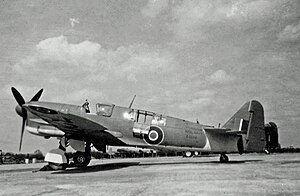Fairey Firefly
| Firefly | |
|---|---|
 |
|
| Operational FAA Fairey Firefly FR.1 wearing late World War Two camouflage | |
| Role | Carrier fighter |
| Manufacturer | Fairey Aviation Company, Ltd. |
| First flight | 22 December 1941 |
| Introduction | 1943 |
| Retired | 1956 (Royal Navy) |
| Primary users |
Royal Navy Royal Australian Navy Royal Canadian Navy Royal Netherlands Navy |
| Produced | 1941–1955 |
| Number built | 1,702 |
The Fairey Firefly was a British Second World War-era carrier-borne fighter aircraft and anti-submarine aircraft of the Fleet Air Arm (FAA). It was superior in performance and firepower to its predecessor, the Fulmar but entered operational service only towards the end of the war. Designed to the contemporary FAA concept of a two-seat fleet reconnaissance/fighter, the pilot and navigator/weapons officer were housed in separate stations. The design proved to be sturdy, long-ranging and docile in carrier operations, although the limitations of a single engine in a heavy airframe reduced its performance.
The Fairey Firefly served in the Second World War as a fleet fighter but in postwar service, although it was superseded by more modern jet aircraft, the Firefly was adapted for other roles, including strike operations and anti-submarine warfare, remaining a mainstay of the FAA until the mid-1950s. UK and Australian Fireflies flew ground attack operations off various aircraft carriers in the Korean War. In foreign service, the type was in operation with the naval air arms of Australia, Canada, India and the Netherlands whose Fireflies carried out a few attack sorties as late as 1962 in Dutch New Guinea.
Before the war, in 1938 the Air Ministry issued two specifications for two naval fighters, a conventional and a "turret fighter". Performance for both was to be 275 knots at 15,000 ft while carrying an armament, for the conventional fighter, of eight 0.303 Browning machine guns or four 20mm Hispano cannon. This would replace the Fulmar which had been an interim design. These specifications were updated the following year and several British manufacturers tendered their ideas. Further changes to the official specification followed, the turret fighter specification was dropped and a modified specification issued to cover single and dual seat fighters capable of 330 and 300 knots respectively. Fairey offered designs that could be single or two seater and powered by the Rolls-Royce Griffon, or a larger airframe with a Napier Sabre. After consideration of manufacturers responses, Specification N.5/40 replaced the earlier specifications. Due to the necessity of navigating over open sea, it was for a two-seater alone. For defence of naval bases a separate single seater design would lead to the Blackburn Firebrand.
...
Wikipedia
